When to sow a strawberry?
The best time to plant your strawberries is between mid-August and mid-October, so in the early fall. This period is ideal because the soil is still warm and rooting is easier. The plants will begin to give to the next season. In cooler areas, you can do it earlier.
Bucket strawberries that are marketed can be installed in the spring. The ascending varieties produce in the first year.
Which varieties to choose?
Among strawberry plants, there are two varieties: the vines you pick between June and the first frost, either by wave or continuously. Non-ups are mostly large fruits and generally gather between mid-May and late July.
If you are true strawberry lovers, you will grow both species to extend the pleasure of tasting to the maximum.
1. The rising strawberries
The Mara des bois (Fragaria x ananassa): It is in the form of a small fruit and conical. These are very fragrant strawberries reminiscent of wild strawberries. It is harvested between June and until the first frosts. She likes balconies, terraces and small spaces. It is very productive because only one foot can harvest almost a kilo of strawberries. It's perfect for beginners because it's easy to grow.

The Anabelle (Fragaria x ananassa) : its fruit is not very sweet and slightly acidic, juicy and rather big with firm flesh and bright orange red. It gives 3 to 5 fruits per bouquet, but you can harvest it regularly throughout the season since it does not experience any interruption of production. Children particularly appreciate it and it is not very sensitive to diseases.
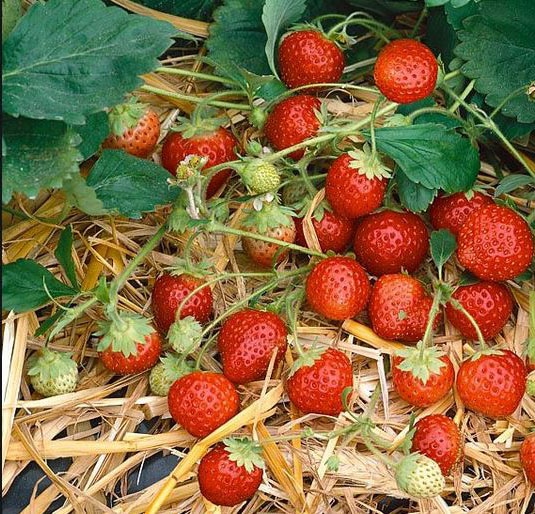
The Queen of the valleys (Fragaria vesca) : It is a real wild strawberry with a very delicate perfume and a small fruit. It is very suitable for planters and suspensions. You can harvest it between May and the frosts continuously. She does not produce stolons. It does not have a big productivity, but it is easy to succeed.
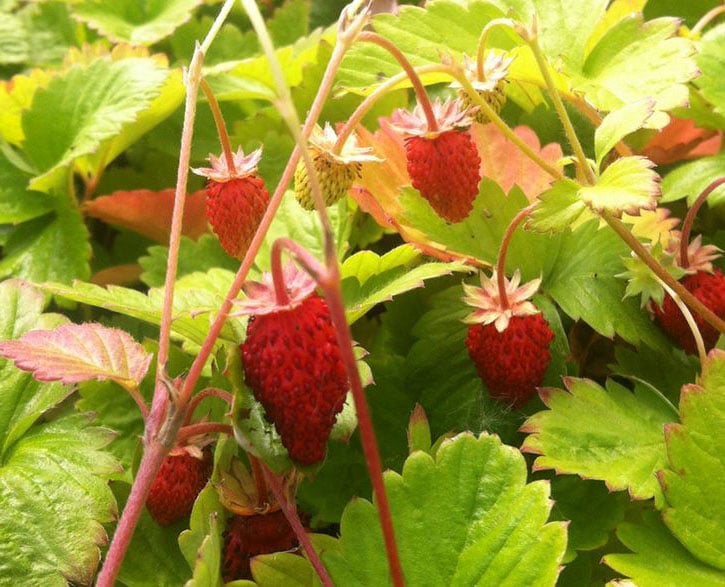
The Mariguette (Fragaria x ananassa): Its fruit is quite large and elongated orange-red. Its flesh is firm, very fragrant and sweet. You will feel a hint of acidity. It has a very abundant production between the end of May and until the frosts. She is easily satisfied with small spaces. It is well preserved and its productivity is important. We find in this strawberry the qualities of the Mara des Bois and Gariguette.

Mount Everest (Fragaria x ananassa) : its fruit is red, of medium size, tasty and tender. It presents undeniable taste qualities. It is a climbing rose that rises to 1.50 meters. You can train it on a trellis, against a wall or drop it from a suspension. It produces a lot of fruit between mid-June and the first frosts. These strawberries are easy to pick since they are close at hand.
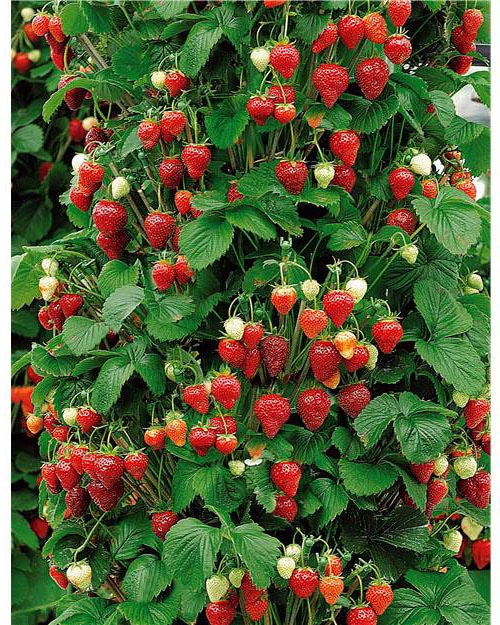
The charlotte (Fragaria x ananassa) : its fruit is blood-red, medium-sized, shiny, firm and heart-shaped. This strawberry has a sweet taste and low acid with a strawberry aftertaste quite pronounced. Its flesh and mellow and it is harvested from June to frosts. It goes back easily throughout the season. It is a hardy and hardy variety. These fruits are very good.

The Tarpan (Fragaria x ananassa) : these strawberries give medium bright red bright, sweet, fragrant and juicy fruits, elongated. It is a strawberry at the falling port with long stolons. The fruits are harvested by wave between June and the first frosts. They like pot and suspension. It is a plant that gives many large dark pink flowers throughout the summer. It offers early flowering and is very decorative.
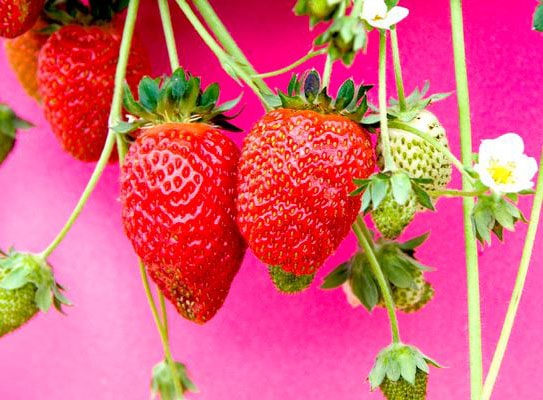
2. Non-rising strawberries:
The garriguette (Fragaria x ananassa) : its fruit is very fragrant, juicy, with soft, elongated flesh and a brilliant bright red. It is harvested between mid-May and mid-June, so it is the earliest variety. It should be tasted ripe or frozen.
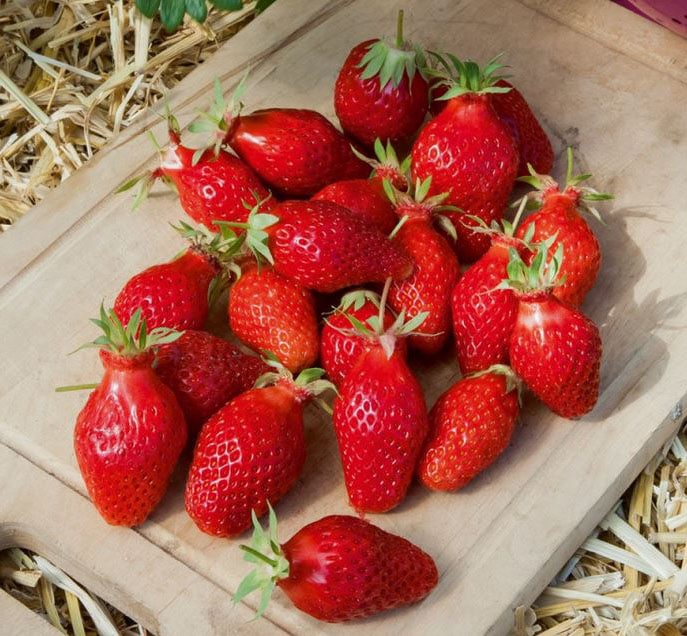
The Ciflorette (Fragaria x ananassa) : its fruit is relatively big, red to orange, very fragrant, firm and elongated. Its flesh is juicy, fine and tender, it has a very good balance of sugar and acidity. It is very early, you harvest it between mid-May and mid-June. It is a variety that is not susceptible to the virus. It is easy to keep and easy to pick.
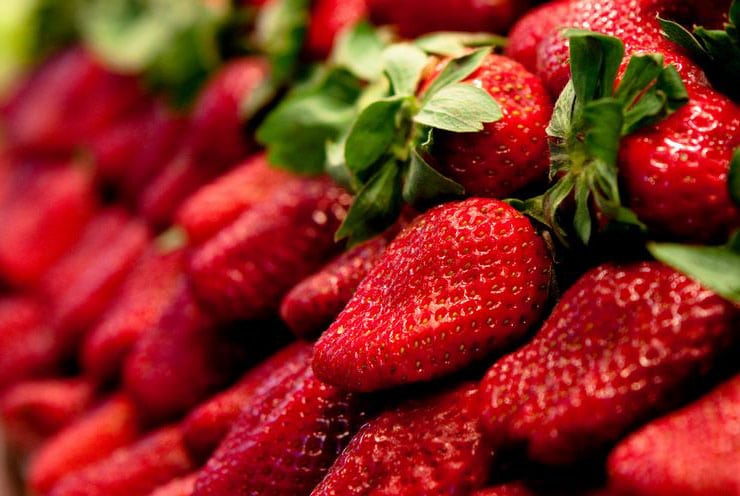 Ciflorette
CifloretteBelrubi (Fragaria x ananassa) : It offers very large fruits elongated with a very bright red currant color. Its flesh is firm, very sweet and red-orange. Very vigorous, these strawberry plants have a good yield and the fruits are harvested between June and mid-July. They are easy to pick and it is a perfect fruit for jam and freezing.
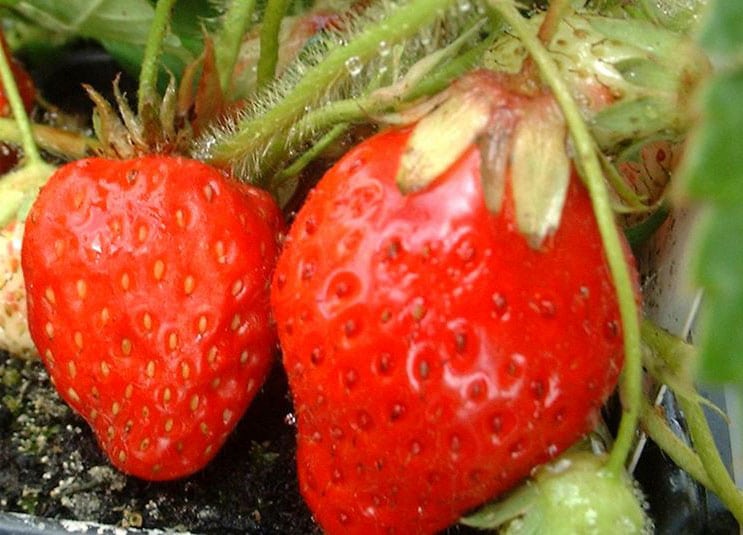 Belrubi
BelrubiMadame Moutot (Fragaria x ananassa) : this strawberry plant offers large fruit with firm and very sweet flesh and excellent flavor. It is harvested from early June to early July and offers very good conservation. It is an old variety for collectors.

The Royal Capron (Strawberry musk or Fragaria moschata): it gives small fruits with firm and juicy flesh and dark pink color. They are harvested from May to June, it is a popular groundcover for places with little sun. Its peculiarity is due to the fact that the floral stems exceed the leaves, it is for this reason that it is called oboe strawberry, they fall under the weight of the fruits. It is a productive and hardy variety that tolerates both wet and cold soils and is very resistant to diseases.
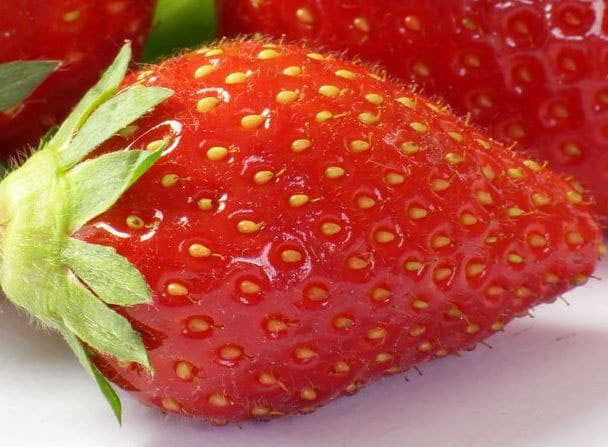
What to do before sowing the strawberry?
Before sowing your strawberries, it is necessary to prepare your soil, hoe it so as to remove all weeds, roots, pebbles and others. Then add an organic fertilizer at the rate of 8 to 10 kilos of well decomposed manure or compost per m² and add a complete natural fertilizer, respecting the indicated doses.
How to sow the strawberry?
You will be very careful about planting your strawberries, and for one simple reason, they will stay in place for a few years.
1. Plant your strawberries in the ground
- If you have decided to plant bare-rooted plants in autumn, it will be necessary to shorten the roots slightly and praline them before planting them.
- If you have an impermeable soil, plant your strawberry plants on a hillock: you need to raise a cultivation board with a width of 60 to 70 cm from 10 to 20 cm. There must be room between two boards. This will improve drainage and promote warming of the land in the spring.
- You must plant your strawberries online and leave a space of 30 cm all around. You put the collar at ground level without raising it or burying it. It is easier to use a bulb plant.
- As soon as you have planted your strawberry plants, water well.
The best is to plant them on a black plastic that helps conserve heat and moisture while preventing weeds from growing. To plant the seedlings, simply drill it every 30 cm.
If your plants already have flowers before planting, they must be removed to prevent the plant from being depleted and to encourage recovery.
2. Plant strawberry plants in pots or in vats
- Take a container at the bottom with holes and at least 25 cm high.
- Spread a layer of shards, gravel, clay balls … to ensure drainage.
- Plant strawberries spaced 15 cm apart.
3. Sowing your strawberries
In a terrine, put a layer of draining: clay balls or gravel:
- Sow in the clearest way possible.
- Do not cover the seed with soil, but pack it lightly so that it adheres well to the seeds.
- To avoid disturbing them, water them with a sprayer.
- The seeds germinate after a week or two.
- During this time, keep your substrate moist.
- As soon as your plants have between 3 and 5 leaves, transplant them into individual buckets.
- Let them winter under a frame.
4. Multiply the strawberry
Every three or four years, you must try to renew the feet, because the strawberry tends to run out very quickly. This operation allows you to benefit from a good harvest permanently.
Varieties that produce large fruits produce stolons. They make new feet by spontaneous layering. You have to separate them from the mother stock and you can replant them elsewhere.
The so-called four-season varieties do not produce stolons. They reproduce only by division of tufts or by sowing. Then divide them every three years.
The sowing is done in summer, between July and September, under cold frame or terrine and the division is done in September.
5. Divide his strawberries
- Select some of the most beautiful feet and discard those who are sick.
- Then dig up the stump by gently pushing the spade around. Separate it into two or three pieces with buds and roots.
- Then replant the shards having been careful to prepare your soil and have enriched. Cut the roots in half before planting. Tamp the earth and water.
6. Marcotter your strawberries
Take the healthiest and most vigorous adult plants, they must have no trace of disease or degeneration. We must be very vigilant because with this system, viruses are transmitted very easily and quickly. On healthy feet only, do the following:
- Let the stolons grow, keep only 1 to 3 seedlings per stolon.
- As soon as you notice the appearance of small white roots, cut the stolons to separate them from the mother plants and collect the seedlings that seem the most vigorous.
- Plant them between August and October by following the planting tips that we have detailed above. If the heat is very strong, shade.
Where to plant the strawberry?
The strawberry plant is preferably planted in a deep and loose soil, rich that will stay cool in summer and is either slightly acidic or neutral. You have to find a sunny place for big fruit varieties. The strawberries of the four seasons like the strawberries of the woods support perfectly the semi-shade.
Be careful if the soil is limestone, the strawberry can then suffer from chlorosis, it is a deficiency of iron that leaves yellowing foliage while the veins remain green.
You can also plant it in a pot: just put a mixture of composted garden soil or soil specially dedicated to strawberries and a potting of leaves. Take a 12 cm diameter pot per plant. There are however special pots that are able to accommodate several plants.
How to maintain it?
1. In the open ground
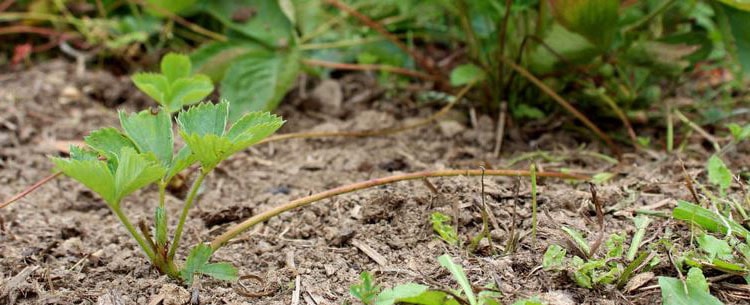
If you did not put plastic at the time of planting, it is necessary to mulch the plantation with dead leaves, pine bark, shredded branches, flakes of flax, cocoa pods … as soon as the soil is warmed. This keeps you dry and delays the growth of weeds. Moreover, in this way, the contact of the fruits with the earth is limited.
Remove stolons regularly, unless you want to renew your feet.
Pace the stolons of the climbing Everest on a support, a trellis or a fence.
It is imperative that the soil is permanently well moist, especially when they are planted in mounds that tend to dry easily.
Strawberries withstand the cold, but they are afraid of spring frosts, in the regions concerned, it is recommended to put a tunnel to protect it.
This plant is demanding and it is best to bring natural fertilizer designed to his attention in early spring and then once the first harvest done.
In the fall, once the last strawberries are harvested, it is essential to clean the plantation:
- Remove damaged and dry leaves, stains and stolons.
- Burn them, do not put them in compost.
- Place a good layer of fallen leaves and compost.
- It is also possible to completely cut the foliage and cover the board with a layer of pine needles, it repels snails and slugs.
2. For the strawberry pot
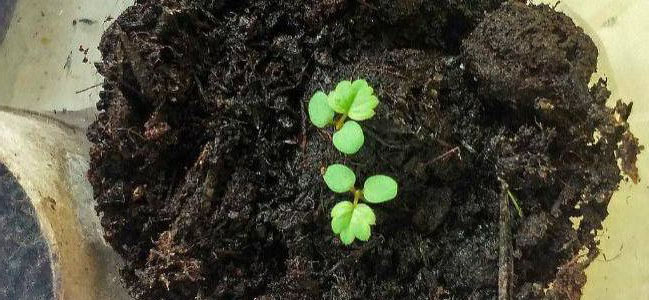
Watch regularly that it is sufficiently watered.
Straw with a mineral material or cocoa husks to maintain moisture.
Cut the stolons as they appear. They tend to deplete the plant, which produces little or no fruit.
Every March, bring a compost on the surface.
How to water the strawberry?
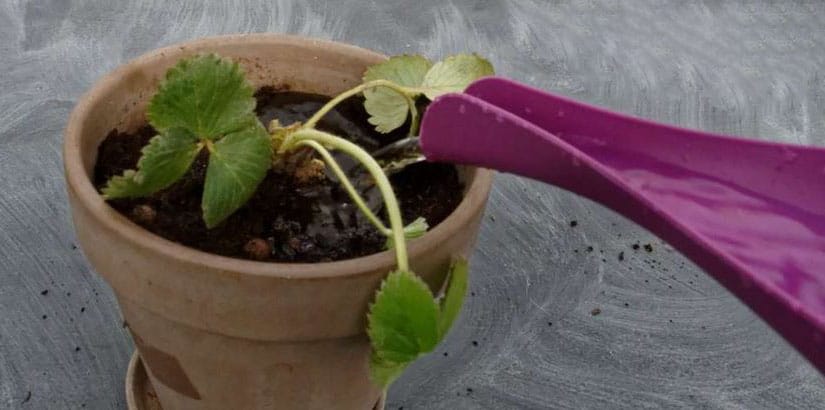
A strawberry plant must be watered regularly, as the soil must always be kept moist.
Harvest strawberries: when and how?
You will reap your strawberries when they are well red and ripe. It must be known that the strawberry will not ripen after being picked. The fruit has to be easily detached from the peduncle in this way you get a powerful flavor.
You can harvest every two or three days, be careful when handling the foot to avoid damaging the remaining fruits. It is best to pick them in the morning, they will be more fragrant.
It is necessary to handle these fragile fruits with delicacy and to taste them quickly, because they deteriorate very quickly.
The small strawberries are gathered without the tail while the big strawberries are gathered with the peduncle.
Keep the strawberries
Before stalking, wash your strawberries gently under a trickle of water.
They must be consumed quickly because they do not support shocks or heat. Put them in a large dish and put them in a cool place, at less than 12 ° C. The refrigerator degrades its taste qualities. If you have too much, freeze them in coulis or ice.
Strawberry diseases and what to do?
Strawberries are fairly insensitive to diseases and insects, you still have to be careful:
Do not close the rows to avoid the proliferation of fungi.
Chlorosis : it recognizes the yellowing of the leaves and their drying which ends up killing the plant. It is not a disease, but a deficiency of iron which is due to a soil too calcareous.
Gray mold or botrytis it leads to rotting of the fruit, which then becomes covered with a gray down and sometimes reaches the entire plant. We must throw away the fruits quickly. To avoid this, do not plant too densely and fertilize your plants well to be more resistant.
The purple spots disease : it gives small brown or purple spots on the leaves that eventually dry out. It is then necessary to cut and burn the parts that are affected. You can then remove the leaves that are dried or stained. So you clean the board in the fall. You can spray Bordeaux mixture in the fall and again in the spring before the strawberry plants bloom.
Phytophthora : it is an underground mushroom which brings a bluish tint to the leaves which end up withering when it is hot. The plants then remain fragile and the fruits have a slightly unpleasant flavor.
Powdery mildew : it causes the appearance of a kind of white powder under the leaves, they curl then and are dyed red. The fruits atrophy.
The main pests and pests :
The red spider It is quite common during periods of extreme heat and drought.
The iule of the strawberry : it is a light brown myriapode, which is 2 cm long and which evokes the centipede. They appear when the weather is wet, they agglutinate on ripe fruits and devour them. It is necessary to mulch in order to isolate these insects from the fruits.
The birds are formidable, if they are very present, cover your strawberry with a net before they ripen.
Slugs can quickly invade your strawberry plants, you can pick them up or move them away with traps.








